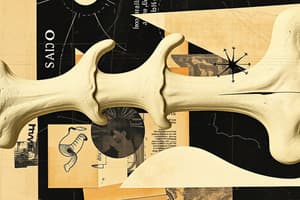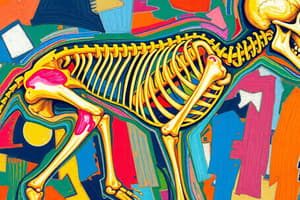Podcast
Questions and Answers
Describe the roles of parathyroid hormone (PTH) and calcitonin (CT) in calcium homeostasis.
Describe the roles of parathyroid hormone (PTH) and calcitonin (CT) in calcium homeostasis.
PTH stimulates osteoclasts to increase bone breakdown, raising blood calcium levels, while CT inhibits osteoclasts to promote bone formation, decreasing blood calcium levels.
What condition results from low blood levels of calcium, and what are its potential implications?
What condition results from low blood levels of calcium, and what are its potential implications?
Hypocalcemia is caused by low blood levels of calcium, potentially leading to muscle spasms, and neurological symptoms.
Explain the mechanism by which PTH increases blood calcium levels.
Explain the mechanism by which PTH increases blood calcium levels.
PTH increases blood calcium levels by stimulating osteoclasts, which break down bone and release calcium into the bloodstream.
How does calcitonin function to lower blood calcium levels?
How does calcitonin function to lower blood calcium levels?
Identify the relationship between calcium absorption in the intestines and vitamin D.
Identify the relationship between calcium absorption in the intestines and vitamin D.
Explain the structural role of lamellae in the Haversian system.
Explain the structural role of lamellae in the Haversian system.
What is the significance of canaliculi in bone tissue?
What is the significance of canaliculi in bone tissue?
Describe the differences between compact bone and cancellous bone.
Describe the differences between compact bone and cancellous bone.
Identify the function of the periosteum in bone anatomy.
Identify the function of the periosteum in bone anatomy.
Discuss the role of osteocytes found in lacunae.
Discuss the role of osteocytes found in lacunae.
What is the significance of the centers of ossification in skull development?
What is the significance of the centers of ossification in skull development?
Describe the transition from cartilage model to bone collar in long bone development.
Describe the transition from cartilage model to bone collar in long bone development.
Explain the role of osteoblasts during the primary ossification center formation.
Explain the role of osteoblasts during the primary ossification center formation.
What is the function of the epiphyseal plate in long bone growth?
What is the function of the epiphyseal plate in long bone growth?
How do secondary ossification centers differ from primary ossification centers?
How do secondary ossification centers differ from primary ossification centers?
What happens to the thickness of the epiphyseal plate during bone growth?
What happens to the thickness of the epiphyseal plate during bone growth?
What cellular process initiates the replacement of calcified cartilage in long bones?
What cellular process initiates the replacement of calcified cartilage in long bones?
Identify the main types of bones represented in the human skull.
Identify the main types of bones represented in the human skull.
How does interstitial cartilage growth contribute to bone lengthening?
How does interstitial cartilage growth contribute to bone lengthening?
What role do chondroblasts play in appositional cartilage growth?
What role do chondroblasts play in appositional cartilage growth?
Describe the process of mitosis in chondrocytes during interstitial cartilage growth.
Describe the process of mitosis in chondrocytes during interstitial cartilage growth.
Explain how the perichondrium contributes to appositional cartilage growth.
Explain how the perichondrium contributes to appositional cartilage growth.
In what way do the processes of interstitial and appositional growth differ?
In what way do the processes of interstitial and appositional growth differ?
What is appositional growth and how does it relate to bone diameter increase?
What is appositional growth and how does it relate to bone diameter increase?
Describe the role of osteoclasts in bone growth and maintenance.
Describe the role of osteoclasts in bone growth and maintenance.
What are primary ossification centers and where are they located in the fetus?
What are primary ossification centers and where are they located in the fetus?
Explain the difference between intramembranous and endochondral ossification.
Explain the difference between intramembranous and endochondral ossification.
List at least three bones that are primarily formed through intramembranous ossification.
List at least three bones that are primarily formed through intramembranous ossification.
Describe the primary difference in the composition of the medullary cavity between young and adult bone.
Describe the primary difference in the composition of the medullary cavity between young and adult bone.
What is the significance of the epiphyseal lines in adult bones compared to the epiphyseal plates in young bones?
What is the significance of the epiphyseal lines in adult bones compared to the epiphyseal plates in young bones?
Identify the structural components characterizing Haversian systems and their function in adult bone.
Identify the structural components characterizing Haversian systems and their function in adult bone.
Explain the role of periosteum in both young and adult bone structures.
Explain the role of periosteum in both young and adult bone structures.
Contrast the types of bone present in young versus adult bone, focusing on cancellous and compact bone.
Contrast the types of bone present in young versus adult bone, focusing on cancellous and compact bone.
What role do osteogenic cells play in the development of bone tissue?
What role do osteogenic cells play in the development of bone tissue?
How do osteocytes communicate within the bone matrix?
How do osteocytes communicate within the bone matrix?
What distinguishes spongy bone from compact bone in terms of structure and function?
What distinguishes spongy bone from compact bone in terms of structure and function?
Describe the function of osteoclasts in bone remodeling.
Describe the function of osteoclasts in bone remodeling.
What is the significance of lacunae in the context of bone tissue?
What is the significance of lacunae in the context of bone tissue?
Explain the significance of concentric lamellae in the osteon structure and their role in bone strength.
Explain the significance of concentric lamellae in the osteon structure and their role in bone strength.
Describe how the structure of trabeculae in spongy bone contributes to its functionality.
Describe how the structure of trabeculae in spongy bone contributes to its functionality.
What is the role of canaliculi in the relationship between osteocytes and their environment?
What is the role of canaliculi in the relationship between osteocytes and their environment?
How do perforating canals connect the central canal to the periosteum, and why is this connection essential?
How do perforating canals connect the central canal to the periosteum, and why is this connection essential?
Discuss the importance of red bone marrow housed in the spaces of spongy bone.
Discuss the importance of red bone marrow housed in the spaces of spongy bone.
What are the primary roles of hyaline cartilage in the skeletal system, and what condition results from its loss?
What are the primary roles of hyaline cartilage in the skeletal system, and what condition results from its loss?
Identify and explain two significant functions of bones related to mineral storage.
Identify and explain two significant functions of bones related to mineral storage.
Discuss the relationship between cartilage and bone in terms of their contributions to the skeletal system.
Discuss the relationship between cartilage and bone in terms of their contributions to the skeletal system.
What types of tissue are involved in the protection of internal organs, and how do they function together?
What types of tissue are involved in the protection of internal organs, and how do they function together?
Explain how adipose tissue contributes to the functions of bones.
Explain how adipose tissue contributes to the functions of bones.
What role do chondroblasts play in appositional cartilage growth?
What role do chondroblasts play in appositional cartilage growth?
Describe the process by which bones grow in length at the epiphyseal plate.
Describe the process by which bones grow in length at the epiphyseal plate.
What is the function of the reserve zone in the epiphyseal plate?
What is the function of the reserve zone in the epiphyseal plate?
Identify the zones of activity in the epiphyseal plate and their significance.
Identify the zones of activity in the epiphyseal plate and their significance.
How does the replacement of cartilage with bone contribute to bone elongation?
How does the replacement of cartilage with bone contribute to bone elongation?
Study Notes
Human Skull Development
- Human skull comprises several bones including parietal, occipital, temporal, sphenoid, frontal, ethmoid, nasal, maxilla, zygomatic, mandible, and vertebrae.
- Centers of ossification appear in different regions, indicating edges of bone growth.
Long Bone Development
- Begins with cartilage model shaped by chondrocytes, surrounded by perichondrium.
- Formation of a bone collar occurs as periosteum forms from perichondrium, leading to cartilage calcification.
- Primary ossification center emerges as blood vessels and osteoblasts penetrate calcified cartilage, initiating bone matrix formation.
- Secondary ossification centers develop in the epiphyses, contributing to bone length via the growth of the epiphyseal plate.
Bone Structure
Osteon (Haversian System)
- Comprised of concentric lamellae surrounding a central canal, enabling nutrient transport via blood vessels.
- Contains osteocytes located in lacunae and interconnected through canaliculi.
Compact Bone
- Dense structure utilizing concentric rings (lamellae) with associated canaliculi and a central canal for blood vessel distribution.
Cancellous Bone
- Features trabeculae that create a porous network, housing bone marrow and blood vessels.
Bones and Homeostasis
- Calcium is crucial in the extracellular matrix of bone; levels are regulated by parathyroid hormone (PTH) and calcitonin.
- Hypocalcemia indicates low calcium levels, while hypercalcemia indicates high levels in the blood.
Cartilage Growth
- Interstitial growth elongates cartilage through chondrocyte division.
- Appositional growth increases width via matrix secretion from differentiating perichondrium cells.
Bone Growth in Diameter
- Osteoblasts in periosteum increase bone matrix on the surface while osteoclasts resorb older inner bone lining.
Intramembranous and Endochondral Ossification
- Intramembranous ossification develops key skull bones while endochondral ossification replaces cartilage with bone in most appendicular skeleton elements.
- Different bones develop at distinct timelines during fetal growth stages.
Bone Structure: Young vs. Adult
- Young bone contains red marrow in medullary cavity; adult bone typically contains yellow marrow.
- Developmental changes include the presence of epiphyseal lines in adult bone.
Anatomy of Epiphyseal Plate
- Four zones facilitate bone growth:
- Reserve zone anchors plate to epiphysis.
- Proliferative zone consists of rapidly dividing chondrocytes.
- Mature cartilage zone contains older cells.
- Calcified matrix zone features dead chondrocytes within bone matrix.
Bone Tissue Types
- Solid connective tissue consists of compact (dense, supportive) and spongy (lightweight, housing marrow) bone.
Bone Cells
- Osteogenic cells are self-replicating stem cells that become osteoblasts, which produce bone matrix.
- Osteocytes maintain bone tissue while osteoclasts are responsible for bone resorption during remodeling.
Bone Functions
- Bones serve multiple functions including muscle attachment, protection of vital organs, mineral storage, blood cell production, and adipose tissue storage.
Cartilage in the Skeletal System
- Hyaline cartilage aids in joint movement and is crucial for bone health; its loss can lead to conditions like osteoarthritis.
- Fibrocartilage is located in tendons, ligaments, and intervertebral discs, providing structural support.
Studying That Suits You
Use AI to generate personalized quizzes and flashcards to suit your learning preferences.
Description
Explore the intricacies of human bone development, including skull formation and long bone growth. Learn about the processes involved in ossification and the structure of bones, specifically the osteon system. This quiz covers essential concepts in human anatomy and skeletal biology.




